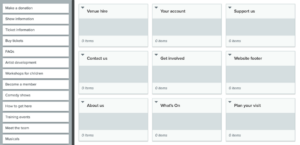
Beginner Read Digital Strategy Websites
Your website is one of your most important assets. Read on to find out how it can make a big impact on your organisation.
In this article

This article is aimed at anyone who wants to improve the effectiveness of their website and improve the experience of their website visitors. You can use a technique called card sorting to do this. Card sorting uses real people to test whether your website content is organised intuitively or not. Don’t worry if this sounds complicated – it isn’t!
It’s likely that you and other stakeholders in your organisation have agreed on the structure of your website. Or perhaps you’ve had input from your web designer or agency (supplier). That’s OK and this is completely normal. But are you testing whether the decisions you have made are correct? Card sorting helps to confirm this, whether you have an existing site or are planning a new one.

Card sorting is a research technique used to gather proven information on how best to categorise and organise website content. It involves participants sorting a set of content cards (or webpages) into categories (navigation) that make sense to them. By reviewing how users categorise and order this content, you get valuable insights into their preferences and expectations. You can then adapt how your website content is organised to address key findings. Easy!
Here is a video explanation from UX Club (launches in a new window)
You can set up a card sorting session in person (with a group of participants) or online. The latter is easy to set up and ideal for your first card sort exercise, which is circulated with a simple web link. We are using a free trial with Optimal Workshop, but there are other platforms you could try. Many tools provide a free or lite option to get you going. Whichever you choose, the process is broadly the same:
We have set up an example card sorting session for you to try. This is based on an imaginary arts venue. Click the link below to see how it works:
https://ows.io/os/5czbvmbe
(You will need this password: DCN2023)
See how easy it is? Now go ahead and create your own!
Card sorting is a valuable tool for any creative or cultural organisation or individual to improve the effectiveness of their website. It’s easy to set up and implement. By involving real people in the process, these organisations gain insights that can inform website structure and content prioritisation. Need help? See below…
The Digital Culture Network is here to support you and your organisation. Our Tech Champions can provide free 1-2-1 support to all creative and cultural organisations and individuals who are in receipt of, or eligible for, Arts Council England funding. If you need help or would like to chat with us about any of the advice we have covered above, please get in touch. Sign up to our newsletter below and follow us on Twitter @ace_dcn for the latest updates.
Beginner Read Digital Strategy Websites
Your website is one of your most important assets. Read on to find out how it can make a big impact on your organisation.
A webinar for creative and cultural organisations and individual practitioners to learn about website sustainability and how to reduce their digital carbon footprint.
Beginner Read Websites
Whether you're creating a brand-new site or reviewing your existing web presence completely, here are some recommendations for making your website as effective as possible.
Beginner Read Digital Strategy Websites
Your website is one of your most important assets. Read on to find out how it can make a big impact on your organisation.
Beginner Read Websites
Tree testing is a quick and easy way to test the effectiveness of your website navigation. It’s a technique that can also test a new website structure you may be planning. A tree test can confirm how easy (or difficult!) it is to find important information on your website. This article by Andy explains it all.
Beginner Read Websites
WordPress is the world’s most popular website platform, and is widely used by creative and cultural organisations. This article gives you 10 top tips to speed up your website.



